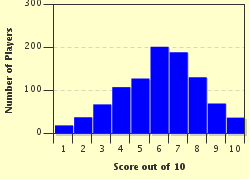Quiz Answer Key and Fun Facts
1. Now parading on the catwalk is a cat named "Spotted Mist". This shorthaired cat has a spotted fur with a hazy effect. In which country did this breed originate?
2. Look at that kitty on the catwalk. It is a large cat with a brownish spotted coat, almost as if it were a miniature leopard. Which shorthaired breed is now parading?
3. Now parading on the catwalk is a Bombay cat. Which colour is typical of the Bombay cats? Don't be too superstitious.
4. Another cat ascends the cat walk. Now is the time the Dragon Li parades, a wild cat breed that can be domesticated. It has a golden - brown tabby pattern. Where does this breed come from?
5. On the catwalk there are now some kitties related to the well-known Siamese cats. Which of these breeds is closely related to the Siamese?
6. The next kitty on the catwalk is a Kurilian bobtail. What is the decisive trait to tell one Kurilian bobtail from the other? This feature is as individual as human fingerprints.
7. Now parading on the catwalk is a cat with deep blue eyes. This cat breed was named after this distinctive feature. What is the name of the breed?
8. Here on the catwalk is a very famous longhaired kitty. This medium sized cat has a wide, round head with a shortened muzzle. It can sport any colour of fur. What is the name for this breed, reminding us of the old name of a Middle-Eastern country?
9. Now on the catwalk is a new breed, the Savannah cat. What is the abbreviation for the Savannah International Members and Breeders Association?
10. On the catwalk there is a Sokoke cat, also named Khadzonzos cat. A third, less used, name refers to the continent they come from. What is the third name of this breed?
Source: Author
JanIQ
This quiz was reviewed by FunTrivia editor
crisw before going online.
Any errors found in FunTrivia content are routinely corrected through our feedback system.

